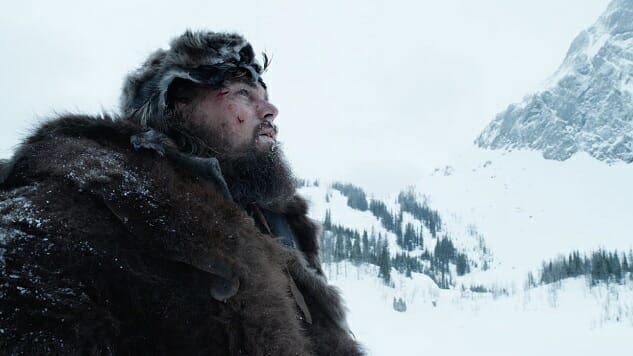
For aficionados of brutal genre films, Alejandro González Iñárritu’s The Revenant has enough to keep you satisfied. Find scenes of bravura violence photographed by an eminent cinematographer (the great Emmanuel Lubezki). Find the vague impression of deep, abiding meaning. Find bear-mauling, equine disembowelment. Find rape, castration, graphic suffering. Find additional suffering. Find more suffering. And all of this Iñárritu presents without flinching.
What the film lacks, though, is resonance or empathy. If Quentin Tarantino’s The Hateful Eight glories in his characters’ wanton and widespread amorality, Iñárritu skirts it with hints of respectability—though The Revenant isn’t actually a respectable film. It’s a tale of primal comeuppance wrapped in prestige’s clothing. It’s about fur trapper Hugh Glass’s legendary 1823 journey of frontier martyrdom, but it also isn’t. There is a character named Hugh Glass here, portrayed with unhinged commitment by Leonardo DiCaprio, and the film does depict his long crawl to civilization after being left for dead in the wilderness. But there isn’t a thought driving Glass’s struggle for survival save for a thirst for retribution and an impulse to relish in manhood under duress. It is depiction without consideration. The film never gives us a greater reason to care about Glass’s travails than the murder of his son, Hawk (Forrest Goodluck), at the hands of a fellow trapper, Fitzgerald (Tom Hardy, jack of all accents).
The three begin as tenuous comrades, fleeing from a group of Arikara Indians, who ride to rescue their chief’s kidnapped daughter. Fitzgerald has an immediate beef with Glass and with Hawk, who happens to be half Pawnee. This is the narrative’s core through line, which pays off when Glass, clinging to life after having a frank exchange of ideas with a mama grizzly, is abandoned in the snow-blanketed woods by Fitzgerald, who stabs Hawk to death on his way out of Dodge.
And that’s it. The movie doesn’t need much more than that, but more is what you get with Iñárritu. The Revenant is about as indulgent and unrestrained as a movie made by someone other than Peter Jackson or Zack Snyder can be, Iñárritu ignoring all ideas of careful filmmaking and doing his own thing. Which is fine to an extent—Iñárritu’s “own thing” is thrilling when taken in capsules. Glass wrestling the bear is gratifyingly intense, a protracted sequence where the camera’s swaying and swinging gives us the sense of being as helpless and prone as Glass himself. It’s immersive technical filmmaking, but the problem is that too much of the film is both sensory and unrelentingly savage. Less really is more.
If there’s anything worth praising about The Revenant, it’s that, hollow or no, it sure looks pretty. The film is a visual marvel. In shot after shot, Mother Nature and human nature alike are captured in pristine form, like insects trapped in amber. A misty mountaintop here, river rapids there, bloodshed everywhere: Iñárritu captures beauty and barbarity alike with sublime clarity. He forgets, though, to sculpt his images into a story.
After the fourth pulse-pounding encounter with one of the film’s varied antagonists—being the elements, mostly, but also animals, roaming Arikara, and occasional Frenchmen—The Revenant becomes an abusive act upon Iñárritu’s audience and DiCaprio himself. Which is maybe the point. Maybe we’re meant to identify with Glass through sheer cinematic brute force (though a rare, lovely scene where Glass and a sojourning Pawnee Indian laugh as they catch snowflakes on their tongue says otherwise). If so, it doesn’t make enduring the film any more rewarding. Iñárritu is good at staging the trials and traumas that endlessly befall his hero. He’s less adept at figuring out why any of it matters beyond the obvious, though to him the obvious isn’t obvious enough, so he spells out visual metaphors and plainly lays out through text the basic message of every revenge-based genre movie ever.
There is nothing new to be learned here, though The Revenant does occasionally muse over a fundamental question: Is the civilized world harsher than the natural world? Might be, but Iñárritu is too busy orchestrating manly fights and tormenting his star to expand on this accidental theme. If you know anything about The Revenant, you probably know that filming it was pure hell and that nobody had it worse than poor Leo. The truth is, nobody cares, but DiCaprio works like a man possessed even though the role requires him to mostly chew dirt, scream and grimace. One conversation toward the end between him and Domhnall Gleeson gives DiCaprio the chance to actually explore Glass’s psyche and make a character out of him. The scene doesn’t last long, but it validates DiCaprio’s Best Actor stumping single-handedly.
If only his performance existed in a substantial movie. There is a simple pleasure to the absence of self-justification in The Revenant, of course: The film doesn’t require much thought in order to engage with it, only two and a half hours’ worth of patience. Tucked and folded within The Revenant’s fatty, sumptuous layers, there’s a good 100-minute movie that’s less plodding, more focused, and equipped to hold our interest despite its speciousness. But Iñárritu appears less concerned with his characters’ manhood than his own. Rather than observe Glass’s agony, The Revenant and its PR campaign both observe how Iñárritu inflicts that agony on him, and for no more noble reason than because he can. It’s a Malick film by way of Gibson and Herzog—but mostly The Revenant is a testament to Iñárritu’s machismo.
Director: Alejandro González Iñárritu
Writer: Mark L. Smith, Alejandro González Iñárritu, Michael Punke
Starring: Leonardo DiCaprio, Tom Hardy, Forrest Goodluck, Domhnall Gleeson, Will Poulter
Release Date: December 25, 2015 (NY/LA); January 8, 2016 (wide)
Boston-based critic Andy Crump has been writing online about film since 2009, and has contributed to Paste Magazine since 2013. He also writes for Screen Rant, Movie Mezzanine, and Birth.Movies.Death. You can follow him on Twitter. He is composed of roughly 65% craft beer.